Millennium Project
Rob Forsyth
This is an amalgamation of two previous and separate articles - see acknowledgements at foot of article
|
The Pest House |
The Almshouses | |
|
|
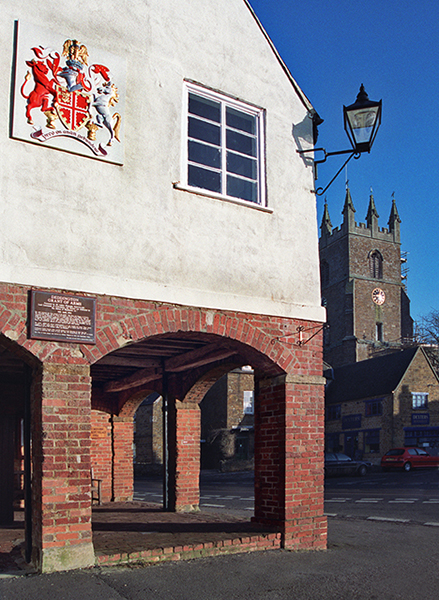
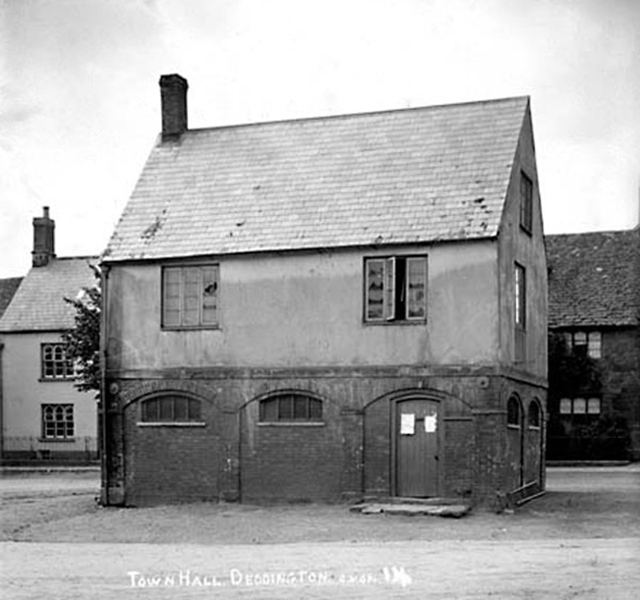
17th CENTURY
In 1611, Deddington acquired a ‘Town House’, subsequently known as the
Town Hall. It was built under the auspices of the local Trinity Guild, a
group of well-to-do local residents who traditionally paid the
‘fifteenths’, a tax levied on property owners for the maintenance of the
parish poor. Such Guilds had existed since at least the 12th century,
and could be either religious or secular in origin and were often both.
All we know of this first Town Hall is that it was a brick building and
certain shops or stalls were built 'under or adjoining the same'
(Commission of Charitable Uses – 12th and 13th Reports). Rents from
these stalls were used for charitable purposes, in keeping with the
Guild’s remit.
THE FEOFFEES
in 1612 the structure of
Deddington’s Feoffees (today’s Trustees) was reviewed and a tighter
system of governance set up. In 1601, during the reign of Elizabeth 1,
the Statute of Charitable Uses became law. A Commission was set up to
examine the administration of charitable gifts country-wide, certain
malpractices having developed over time. In 1612 the Commission turned
its attention to Deddington. At 'an inquisition, taken at Chipping
Norton' it listed various premises, land and rents in Over Worton,
Bloxham, Deddington and Hempton that provided Deddington’s charitable
income. Donations from individuals were also noted and the Hermitage, in
the Market Place, was mentioned by name as being 'employed for and
towards the relief and maintenance of the poor' of the parish.
Presumably not satisfied with existing administrative practices, the
Commissioners decreed in April 1612 that, 'Thomas Maynett esquire, and
11 others, herein named as being the sufficientest freeholders and
holders, were nominated the feoffees of the said lands', etc. Management
procedures were carefully set out, financial accountability being of
primary importance. The upper storey of the Town Hall
served as the Feoffees’ office and the building was administered by
them.
1826 The Charity Commissioners compiled a report of lands owned by the Feoffees
19th CENTURY
The Town Hall then disappears from the history books until the 19th century.
| In 1806 the Town Hall was rebuilt, presumably from necessity. The exterior (see VCH,
Vol. X1) was 'brick with marlstone dressings and rendered timber
framing, Welsh slate roof with brick gable stack … two storeys. Ground
floor has an arcade of segmental arches … the bay at the northern end is
built upon but the rest is open. Rendered upper floor … Steep pitched
roof'. Six windows are mentioned. The interior is described as having
'intersecting chamfered beams and lateral beams [that] relate to an
earlier wholly timber-framed structure'. This basically is the building
that still stands in the Market Place today. The cost was shared by the
parish, the Feoffees and the three Lords of Deddington Manor. In 1832
the building was repaired, costs again being equally shared. |
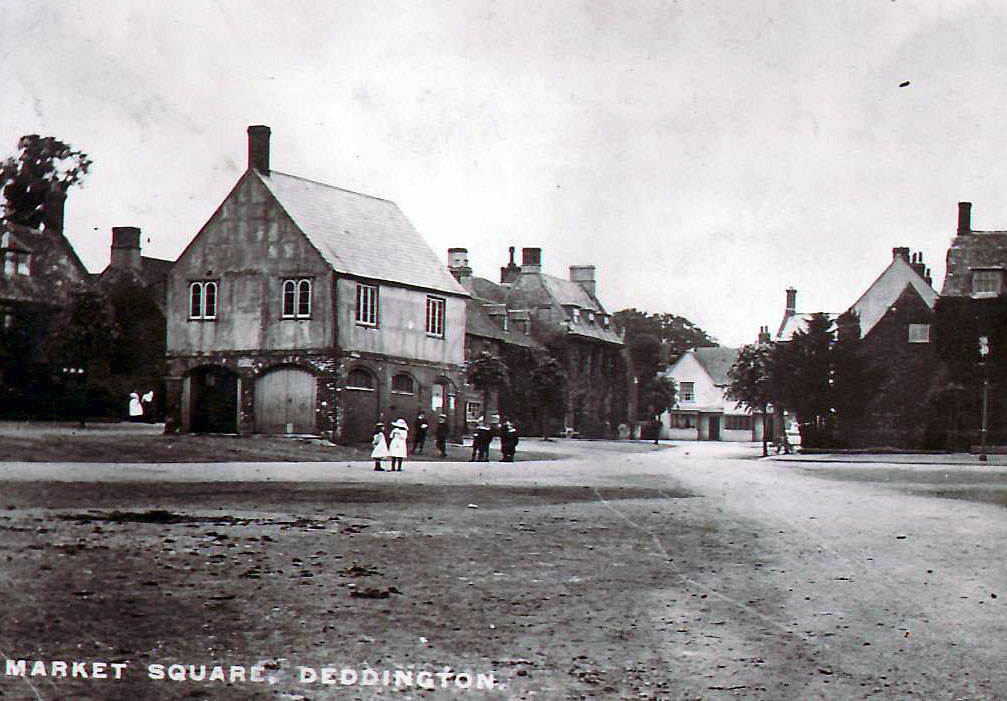 |
In June 1837 a Feoffee meeting at the Town Hall "it was agreed thereat to build a coal house for the poor in the Tchure and a privy for the use of the school - also an engine house under the Town Hall adjoining the cage used for prisoners" There is also mention in the Diaries of the Revd Cotton Risley of the plan to house the parish fire engine under the Town Hall. This involved bricking up the open archways that supported half the upper storey. There is a small puzzle here. In H.M. Colvin’s History of Deddington, the fire engine is noted as occupying this space in 1856. Could it really have taken 19 years to augment the original suggestion made at the Feoffees’ meeting? The bricked up arches provided a shelter for the parish fire engine up until the 1930s.
We also know from entries in Risley’s Diaries that in 1838 the Hall was used for the Annual Court Leet which was a local court of justice dealing with agricultural standards – fascinating and worthy of separate research). Risley also mentions that in September 1839 the second Horticultural and Floral Society Exhibition was held in the Town Hall and he himself won prizes in the 1841 exhibition.
In 1856 the Scheme for the Management of Deddington Charity Estates (another management review, when careless practices were examined and the Feoffees changed their status to Trustees) describes the Town Hall as 'unoccupied and useless'. However, Colvin reports that it was used 'for vestry meetings and as a court house. It also served as a polling station for county elections and, from 1858, as a Reading Room and Library'.
20th CENTURY
TRUSTEES’ MINUTES
After 1856 the Town Hall, apart form a brief mention of repairs,
again disappears from view and the next source of information is the
Trustees’ Minute Book, recording meetings held from January 1906 to
March 1988.
During the Second World War (actually from December 1940 to March 1945)
the Trustees’ meetings were held at the Vicarage. Otherwise, until March
1966, all meetings are in the Town Hall. After that, the Holly Tree
Club, the Primary School, Deddington Manor and the Vicarage are minuted
as alternative locations. Irritatingly, no reasons are given for this
occasional change of venue although it probably coincides with the Town
Hall being leased to the Parish Council.
The Minutes provide a fascinating account of the social and cultural
changes taking place in the 20th century. From 1909 various sporting and
social clubs, provided they are 'non-political and non-sectarian' are
now offered the use of the Hall for a small rent. In 1912 it was agreed
that the rent would be 1/- with an extra shilling charged for gas. There
were exceptions - Vestry and School Meetings were to be free and later,
the Hospital Finance and Nursing Association was extended the same
exemption. In 1913 permission is given to hold non-sectarian Bible
Reading meetings for young men on Sunday afternoons. (What were the
young women doing?) The County Council Lending Library hires the
upstairs room for two nights a week in 1926. In the same year the Parish
Council rents 'the undercroft' to house the steam fire engine, modern
successor to the mighty engine of 1856.
26 July 1926 Letter from Revd Buckingham for the use of the Town
Hall for two nights each week for a County Council lending library on
payment of the cost of the gas consumed
A charge of one shilling per meeting for the use of the Town Hall.
Except for the Hospital Finance and Nursing Association to have room
free of rent for their meeting
8 November 1926. The School was asked to return the oak table which they had had use of and which belonged to the trustees.
In 1928 the Town Hall is mentioned as being used for 'a Labour Exchange' and a rent of 3/- per week is charged.
The installation of electric lighting is debated in
1932.
WORLD WARS
While there are no references in the Trustees’ Minutes to the First World War, the Second World War is recorded obliquely. In 1940 the Town Hall’s upper floor and the coal place are let to the Deddington Platoon of the Home Guard.
11 March 1941 Arrangements completed for letting the upper floor of
the Town Hall and the coal place under the staircase as headquarters
for the Deddington Platoon of the Home Guard for a rent of £10 per
annum.
Recipients of coal tickets still mentioned.
15 January 1946 Agreed to use of the Town Hall (once de-requisitioned) as HQ for Deddington and District Home Guard Club on Wednesday, Thursday, Friday and Saturday at a rental of £10 for one year. The Town Hall to be used on Monday and Tuesday for “Parish meetings, Lectures and other functions.The Hall is then officially de-requisitioned by the War Department.
The Home Guard notice board is mentioned as up for repair in 1949, suggesting that the Home Guard was still going strong, four years after the War had ended.
Finance is more readily available after the priorities of War come to an end. A rent for electricity is mentioned in the Minute Book in 1946, so presumably gas was on its way out. However, we read in the Minutes of Feb. 1947 that 'it had not been possible to arrange with the Wessex Electricity Co. or the Gas Co. to install heating arrangements in the Town Hall and it was decided to carry on with coal fires'. A Minute Book entry in 1953 draws the Trustees’ attention to the shabby condition of the Town Hall interior. P A Franklin and Sons carry out redecoration work in 1954, at a cost of £74.00.
LEASED TO THE PARISH COUNCIL
The next milestone in the Town Hall’s history happens in 1965. The minutes for October record an offer from the Parish Council 'to take a lease of the Town Hall for a period of 20 years, at a rental of £75 a year. The offer was subject to vacant possession of the whole property'. After debate, this offer was accepted. Draft lease was approved on 2 March 1966.
Problems arose almost immediately as to which body should pay for urgent repairs to the Town Hall timber. A deferment of rent was agreed upon.
The fact that there were tensions over this issue is probably confirmed by a note in the minutes of March 1967. The Clerk agrees to 'Ask the Parish Council if they would consider not taking advantage of the offer to allow them to defer payment of rent of the Town Hall'. Official minutes excel at drawing a veil over human emotions.
Renovations to the Almshouses and related modernisation occupy the Trustees for the next 20 years. There is no mention in the Minutes of any money being spent on the Town Hall itself which is not surprising as the lease to the Council was a full repair and maintenance lease.
In October 1987 the Clerk reports that 'he had discovered (!) that the 20 year lease of the Town Hall to Deddington Parish Council had expired in March 1986'. The Trustees readily agree to offer to renew the lease for a further 20 years at a rental of £75pa and on similar terms, i.e. the PC 'being responsible for all outgoings – all repairs, rates, insurance etc.'.
MILLENNIUM PLANS
During the 1990s various ideas were put forward by the Trustees to celebrate the year 2000. The Town Hall was to be renovated, substantially modernised and possibly used as a museum. Three architects’ quotations were considered, including a substantial Feasibility Report from Norman Machin Associates.
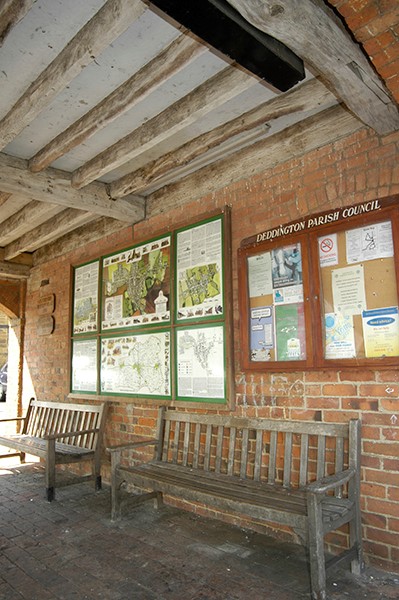 The decade rolled on and a Millennium Working Group, under the auspices of the PC, circulated a questionnaire, asking parishioners to choose a village project to celebrate the year 2000. Of replies to a questionnaire 26% were in favour of a Town Hall modernisation scheme. Ultimately, however, all plans were put on hold, basically over the question of ownership. The PC’s lease of the Town Hall was up for renewal again in 2006 and there was stalemate over whether this lease should be renewed or the building be sold to the PC (see Millennium reports on DOL).
The decade rolled on and a Millennium Working Group, under the auspices of the PC, circulated a questionnaire, asking parishioners to choose a village project to celebrate the year 2000. Of replies to a questionnaire 26% were in favour of a Town Hall modernisation scheme. Ultimately, however, all plans were put on hold, basically over the question of ownership. The PC’s lease of the Town Hall was up for renewal again in 2006 and there was stalemate over whether this lease should be renewed or the building be sold to the PC (see Millennium reports on DOL).
click on image for larger version
In the end, as far as the Town Hall was concerned, the Millennium was marked by the installation of a board showing the Map Group’s work on Deddington’s history. This covers a large section of the external south wall of the Hall, in the undercroft. The area is now also used as a bus shelter and for charity stalls and it serves a variety of purposes during the monthly Farmers’ Markets. PC and parish notice boards have been installed here.
21st CENTURY
The celebration of the completed renovation of the Town Hall took place on 26 September 2015.
The local MP, Victoria Prentiss, cut the tape, the band played, the sun shone, and the market was buzzing. The refurbishment work was carried out by local firm Catling & Catling Ltd. The undercroft still houses the 2.5m x 1.5m maps of the Parish, created as a millennium project by the Map Group. It still shelters passengers waiting for buses to Banbury, Deddington Brass plays there (as here on the occasion of the opening of the refurbished building); and its market connection is retained when it hosts stalls at the monthly Farmers’ Market. In the pic on the right are Dr Rose Todd (CDC Conservation Officer, Tim Catling, Revd Annie Goldthorp, John Sampson, George Fenemore, Leah Calcutt and Victoria Prentiss (pic courtesy Judy Ward). | 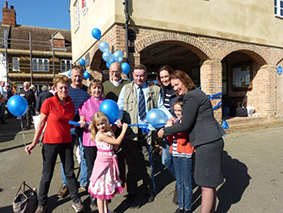 |
The Trustees were delighted with their efforts to bring the building back to life and their thoughts went back to the year 1611 when three stalls were introduced to the undercroft of the new Town House and the then Feoffees were charged with utilising that income for the upkeep of the Almshouses. Today the letting of the Town Hall complete discharges that obligation.
Today
On the southern wall is the Coat of Arms granted to Deddington on 16 April 1994, one of only
six or seven villages to be granted arms and Deddington is the first
Parish in all England, never having been a chartered borough, to have
supporters granted to its arms. The motto in Early English - preo on anan gebundene,
meaning 'three joined together in one' - refers to the three manors of
the Parish and to the three villages Deddington, Clifton and Hempton.
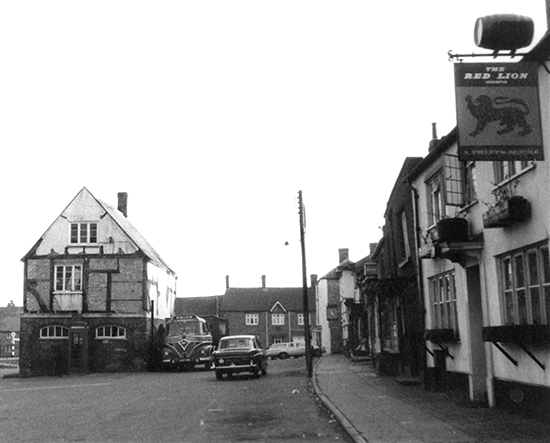 Against the north wall is a classic red type K6 cast iron telephone kiosk, the type designed in 1935 by Sir Giles Gilbert Scott.
Against the north wall is a classic red type K6 cast iron telephone kiosk, the type designed in 1935 by Sir Giles Gilbert Scott.
The Town Hall is administered by the Deddington Charity Estates,
a charitable body (regd no. 1188691) who also go under the wonderfully
feudal name of Feoffees (persons invested with a freehold estate in land
for charitable purposes).
Acknowledgements
With thanks to Kristin Thompson (updated 2015)
Leah Calcutt and the current Trustees of Deddington Charity Estates for the loan of the Minute Book for 1906–88
Bibliography:
Victoria History of the County of Oxford, Vol. 19 ed. A. Crossley (London: Institute of Historical Research, 1983)
A History of Deddington Oxfordshire, H.M. Colvin (London: SPCK, 1963)
Early Victorian Squarson – The Diaries of William Cotton Risley 1835–1848, Selection by Geoffrey Smedley-Stevenson Vol. 29 (Banbury Historical Society, 2007)